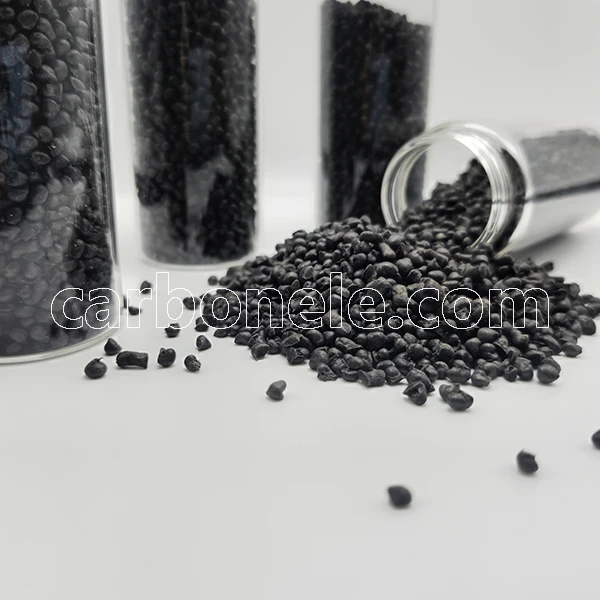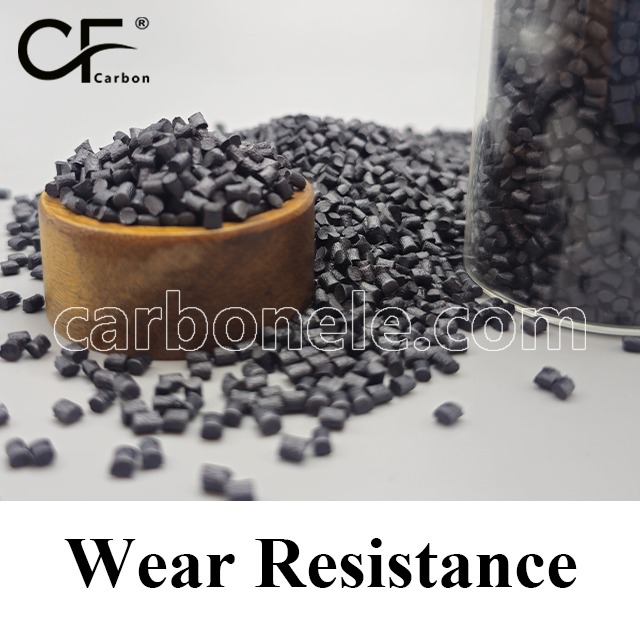
TPU CF30 Prices Per KG 30% Carbon Fiber TPU Manufacturer
TPU CF30 is a composite material that is high in strength, modulus, lightweight, wear-resistant, corrosion-resistant, and has good electrothermal properties. It is suitable for numerous high-end industrial application fields.
- Manufacturer: Carbon New Material
- OEM/ODM: Acceptable
- Color: Black
- Free Samples: ≤25kgs
- MOQ: 100kgs
- Port: Xiamen
- Model number: TPU-CF-BCA3
What’s TPU CF30?
TPU Carbon Fiber 30% is a high-performance material that combines thermoplastic polyurethane (TPU) with 30% carbon fibers. This material integrates the elasticity and durability of TPU with the high strength and rigidity of carbon fibers, presenting a series of unique advantages.
Why to choose 30% carbon fiber filled TPU composites?
Firstly, TPU CF30 features a lightweight characteristic, making it suitable for fields that require lightweight designs, such as automotive components and the aerospace industry. The reduced weight not only contributes to fuel efficiency in vehicles but also enables easier handling and maneuverability in aerospace applications.
Secondly, the high strength and rigidity of this material enable it to perform exceptionally well when subjected to significant loads and vibrations. This makes it ideal for structural components in machinery and equipment where stability and durability are paramount.
Furthermore, TPU Carbon Fiber 30% exhibits outstanding wear resistance. This is attributed to the excellent abrasion and tear resistance of TPU. Even in harsh working conditions with constant friction and rubbing, the material maintains its integrity and functionality.
Simultaneously, this composite material also possesses good corrosion resistance. Carbon fibers have excellent chemical stability, preventing degradation and deterioration when exposed to various corrosive substances.
Another notable characteristic of TPU CF30 is its excellent processability and moldability. As a thermoplastic material, TPU can be processed through injection molding, extrusion, and other techniques. While the addition of carbon fibers may slightly increase the processing difficulty, the composite material still retains a certain level of processing performance, allowing it to meet the customized requirements of products with different shapes. Moreover, the material has an aesthetically pleasing appearance. The unique look of carbon fibers, when mixed with TPU, can endow the product with a fashionable appearance and texture, enhancing its visual appeal.
In terms of electrothermal performance, the TPU Carbon Fiber 30% composite material also demonstrates its potential. By optimizing the carbon content, both the mechanical and electrothermal properties of this composite material are outstanding. The material has the highest electrical conductivity and excellent electrothermal performance, capable of rapidly heating up to a high temperature under a low voltage of 3.5 V. It shows advantages such as controllable electrothermal temperature and stable electrothermal performance.
A specific application of TPU CF30 in electronic equipment shells
30% carbon fiber reinforced thermoplastic TPU composite, with its outstanding performance advantages, has shown great application potential in many fields in the continuous development of material science nowadays, .
In high-end electronic equipment manufacturing enterprises, TPU CF30 has been ingeniously applied to the manufacturing of product shells. These enterprises has always been committed to creating electronic products that are both thin, light, and strong and durable to meet consumers’ pursuit of high quality.
They chose TPU CF30 to make the shells because this material not only has high strength and excellent impact resistance, which can effectively protect the internal precise electronic components from external force damage. Moreover, its good thermal stability and low thermal conductivity can prevent excessive heat accumulation during the operation of the equipment and ensure the stable operation of the equipment.
In addition, TPU CF30 also has excellent chemical corrosion resistance, which can resist the erosion of various chemical substances and prolong the service life of the product.
It is worth mentioning that this excellent material is elaborately developed and produced by Carbon (Xiamen) New Material. With their advanced technology and strict quality control, they ensure the high quality and stability of TPU CF30.
Once this electronic product with the TPU CF30 shell was launched, it was warmly welcomed and highly praised by consumers for its excellent protective performance and good heat dissipation effect.
Learn more details about carbon fiber reinforced TPU compounds, please click here or watch more videos on YouTube.
Should you have any interest in 30% carbon fiber modified TPU resins or other carbon fiber filled thermoplastics, please contact us without any hesitation.
Attributes of Carbon Fibers
1. Exceptional Strength: Carbon fibers have an extremely high tensile strength, making them stronger than many traditional materials. 2. Lightweight: They possess a low density, contributing to reduced weight in products without sacrificing strength. 3. Chemical Resistance: Carbon fibers show great resistance to a wide range of chemicals, ensuring durability in various environments. 4. Thermal Conductivity: They have excellent thermal conductivity, allowing for efficient heat dissipation or heat transfer in specific applications.

Main Traits of TPU
1. Excellent Elasticity: TPU has a remarkable ability to stretch and return to its original shape without permanent deformation. 2. Good Abrasion Resistance: It can withstand friction and wear, making it suitable for products that experience frequent contact and movement. 3. High Toughness: TPU is tough and can absorb impact energy, providing durability and protection. 4. Resistance to Oils and Greases: It is not easily affected by oils and greases, maintaining its properties in such environments. 5. Low Temperature Flexibility: TPU retains its flexibility and functionality at low temperatures, ensuring performance in cold conditions.

Frequently Asked Questions
Carbon (Xiamen) New Material Co., Ltd. aims to provide buyers with "one-stop" worry-free high-quality services. Here you can find all information about carbon fiber engineering plastics. If you still have questions, please send us an email for consultation!
-
How can I contact the manufacturer of a product that interests me?
When you find a product you are interested in, you can contact the manufacturer directly by sending an email and we will get back to you as soon as possible.
-
How do I find the products that interest me?
All you need to do is enter the keyword, product name in the search window and press the Enter key on your keyboard. Your search results page will then be displayed. You can also search within the product category pages on the home page. Each category is divided into subcategories, allowing you to refine your search and find products that interest you.
-
Where will I find a buying guide?
Please contact our after-sales service directly and we will provide you with a comprehensive operating guide.
-
What are CF Reinforced Thermoplastic Composites?
CF Reinforced Thermoplastic Composites are materials where carbon fibers are incorporated into a thermoplastic matrix. They combine the strength and stiffness of carbon fibers with the processability and recyclability of thermoplastics. For instance, they are used in automotive parts like bumper beams.
-
What are the benefits of CF Reinforced Thermoplastic Composites over traditional composites?
The key benefits include faster production cycles, easier recyclability, and better impact resistance. They also offer design flexibility. An example is in the manufacturing of consumer electronics casings where complex shapes can be achieved more easily.
-
How are CF Reinforced Thermoplastic Composites processed?
Common processing methods include injection molding, extrusion, and compression molding. Injection molding is widely used for mass production. For example, in the production of small components for the medical industry.
-
What industries use CF Reinforced Thermoplastic Composites?
They are utilized in aerospace, automotive, medical, and sports equipment industries. In aerospace, they can be found in interior components. In the medical field, they might be used in prosthetics.
-
How does the carbon fiber content affect the properties of the composites?
Higher carbon fiber content generally leads to increased strength and stiffness but may reduce ductility. A moderate content is often balanced for specific applications. For example, a higher content might be preferred in structural parts of a race car.
-
What are the challenges in using CF Reinforced Thermoplastic Composites?
Challenges include higher material costs, complex processing equipment requirements, and ensuring uniform fiber dispersion. Issues with adhesion between the fibers and the matrix can also arise. An example is in achieving consistent quality in large-scale production.
























